How Much To Paint a 3000 square foot House Exterior?
Painting the exterior of your home is an excellent way to enhance its aesthetic appeal, protect it from harsh weather conditions, and potentially increase its value. For a 3,000-square-foot house, the cost of an exterior paint job can vary significantly based on several factors. On average, you might expect to pay between $6,000 and $24,000. Factors influencing the final cost include the type of siding material, the number of stories, the complexity of the architectural design, and the quality and type of paint used. Investing in high-quality paint can ensure a longer-lasting finish, saving you money in the long run by reducing the frequency of repainting.
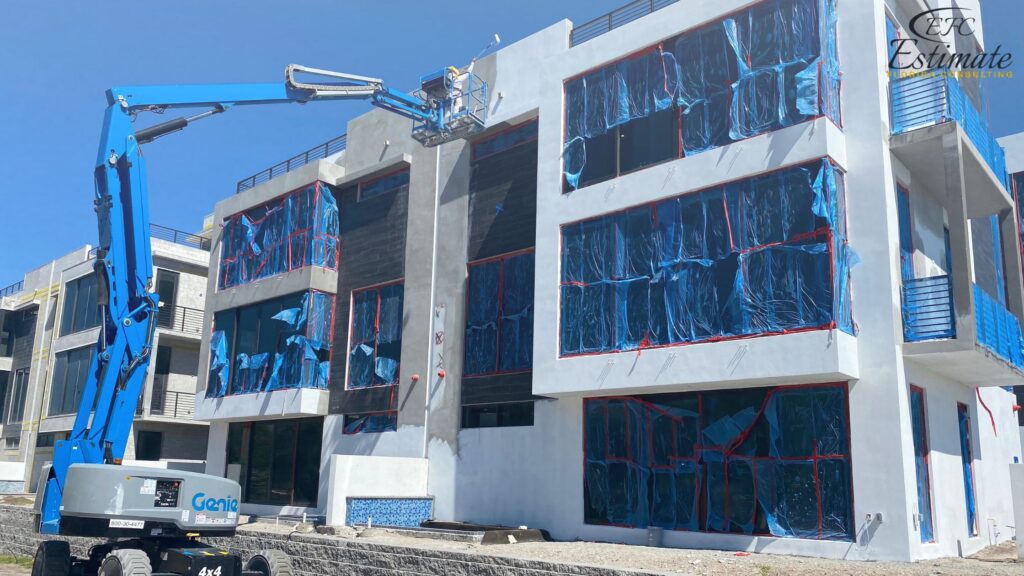
Cost to Paint House Exterior by Story
The number of stories in your house can significantly impact the cost of exterior painting. Multi-story homes require more labor and equipment, such as ladders or scaffolding, which can increase the project’s complexity and duration. Additionally, safety precautions and access challenges associated with taller structures can lead to higher labor expenses. Painting multi-story homes often involves more careful planning and execution, as contractors must ensure proper coverage and finish across all elevations, which may require additional manpower and time.
Single-Story Homes:
Generally easier to paint and less expensive due to the accessibility and reduced need for equipment like scaffolding. These projects often require less time and fewer materials, which can make them more affordable. Painting a single-story home can often be completed more quickly, reducing disruption to your daily routine. Moreover, single-story homes typically have fewer architectural features to navigate, simplifying the painting process.
Number of Stories | Estimated Cost Range |
Single-Story | $4,550 – $9,750 |
Two-Story Homes:
Requires additional labor and equipment, leading to higher costs. Painting a two-story home typically involves more surface area and may require specialized techniques to ensure even coverage across different heights. Contractors often need to use taller ladders or scaffolding, which adds to the complexity and cost of the project. The added height also increases the time needed to complete the project, as workers must move equipment and materials between levels. Proper safety measures are crucial, as painting higher elevations involves increased risk.
Number of Stories | Estimated Cost Range |
Two-Story | $7,800 – $15,600 |
Three-Story Homes:
The complexity and height add significant costs due to increased labor and equipment needs. Ensuring proper coverage and finish on higher stories may require experienced painters with specialized tools. The added height also increases the time needed to complete the project, as workers must move equipment and materials between levels. For three-story homes, the architectural design and intricate details may also require more precise and careful work, further impacting the overall cost. Safety regulations and the need for additional permits or insurance may also play a role in increasing the cost for taller structures.
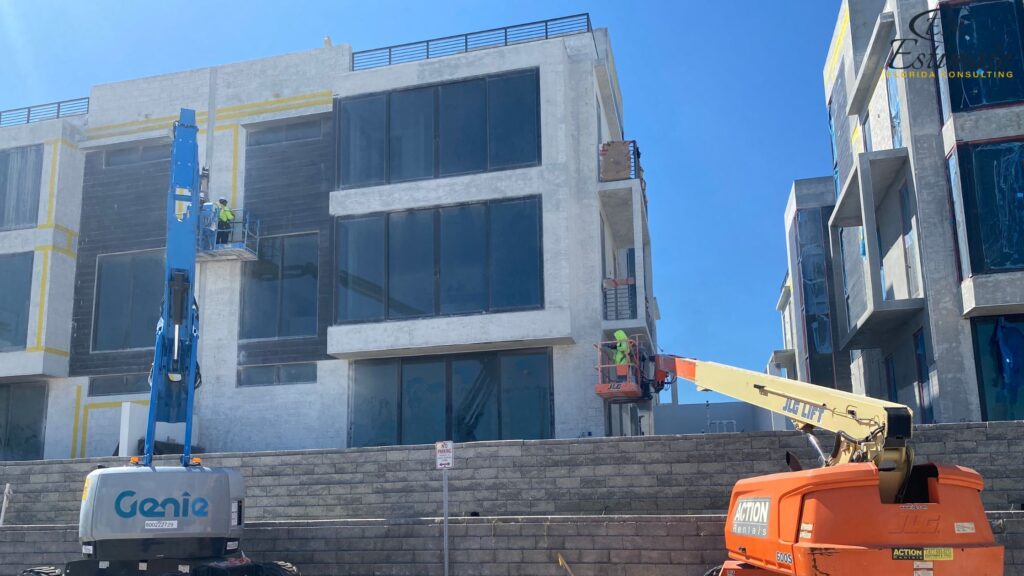
Number of Stories | Estimated Cost Range |
Three-Story | $10,400 – $23,400 |
Cost to Paint House Exterior by Siding Type
Different types of siding materials require different preparation and paint, affecting the overall cost. The type of siding on your home affects the amount of preparation required and the type of paint used, influencing the overall cost. Different materials absorb paint differently and may require specific primers or sealants to ensure longevity and durability. Choosing the right paint for your siding type can help enhance the appearance of your home and protect it from environmental damage.
Vinyl Siding:
Typically less expensive to paint due to its smooth surface and ease of application. Vinyl siding can hold paint well with proper preparation, offering a vibrant and long-lasting finish. The smooth surface allows for efficient application, reducing labor time and costs. However, it’s essential to choose paint specifically formulated for vinyl siding to prevent peeling and ensure a durable finish.
Siding Type | Estimated Cost Range |
Vinyl Siding | $3,900 – $7,800 |
Wood Siding:
Requires more preparation and higher-quality paint to protect against weather and pests. Wood’s porous nature demands high-quality paint and sealant to protect against weather damage and pests. Proper sealing and painting can preserve the natural beauty of wood siding while providing protection against moisture and UV damage.
Regular maintenance is essential to prevent rot and decay, making high-quality paint and preparation crucial for long-lasting results.
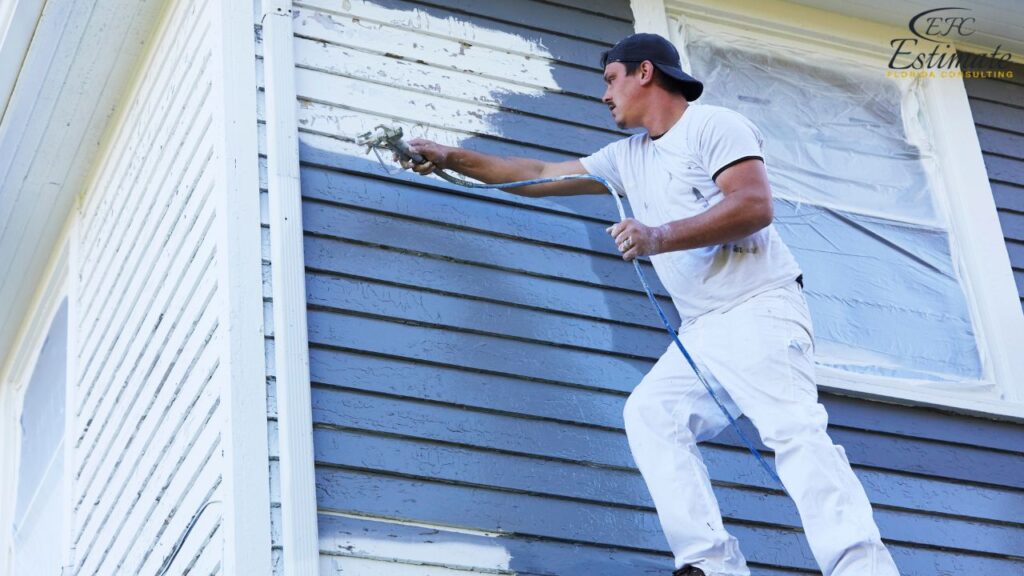
Siding Type | Estimated Cost Range |
Wood Siding | $5,200 – $11,050 |
Stucco Siding:
May require additional materials and labor for repairs and texturing. Stucco often requires specialized paints that can handle its unique texture and provide weather resistance. Repairing cracks and imperfections in stucco can also increase preparation time and costs. It’s important to use breathable paints that allow moisture to escape, preventing trapped moisture that can cause damage to the stucco.
Siding Type | Estimated Cost Range |
Stucco Siding | $6,500 – $13,000 |
Brick or Stone:
Typically involves higher costs due to the need for specialized paints and techniques. Brick and stone surfaces may need a specific type of paint that adheres well and allows the material to breathe. These materials may also require special preparation and cleaning to ensure proper adhesion of the paint. The natural texture and porosity of these surfaces can lead to increased paint consumption, contributing to higher costs.
Siding Type | Estimated Cost Range |
Brick/Stone | $7,800 – $15,600 |
Factors Influencing Exterior Painting Costs
Several factors influence the cost of painting your house exterior, including:
90% More Chances to Win Projects With Our Estimate!
- Multi-Family Building
- Hotel Building
- Hospital Building
- Warehouse Building
- School & University Building
- High-Rise Building
- Shopping Complex
- Data Center Building
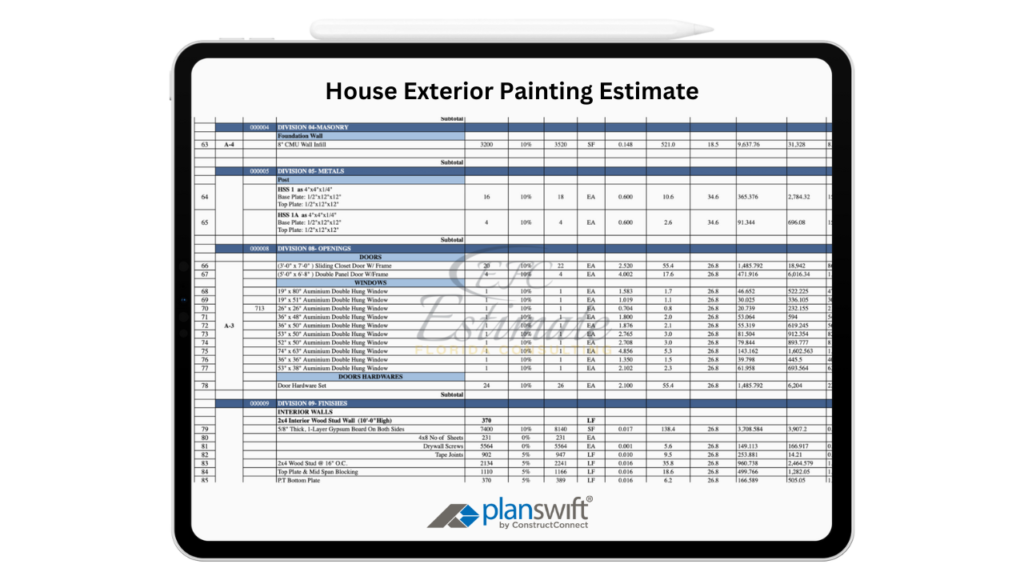
Quality of Paint:
Higher-quality paints offer better durability and weather resistance but come at a premium price. Investing in premium paint can ensure a longer-lasting finish that withstands harsh weather conditions. High-quality paints often provide better coverage and require fewer coats, which can save on labor costs. Additionally, they may include additives that improve mold and mildew resistance, crucial for homes in humid climates.
Paint Type | Cost per Gallon |
Standard Latex | $26 – $52 |
Premium Latex | $65 – $91 |
Acrylic Paint | $39 – $78 |
Oil-Based Paint | $52 – $117 |
Surface Preparation:
Necessary repairs, cleaning, and priming can add to the overall cost, depending on the current condition of the exterior. Proper preparation is critical to achieving a smooth, even finish and extending the life of the paint. Skimping on preparation can lead to premature paint failure and additional costs in the long run. Thorough preparation may involve sanding, scraping, caulking, and applying primers to ensure a stable and even surface for painting.
Preparation Task | Estimated Cost Range |
Pressure Washing | $195 – $520 |
Surface Repair | $650 – $1,950 |
Priming | $390 – $1,040 |
Complexity of Design:
Homes with intricate designs, multiple colors, or architectural details may require more time and effort, increasing labor costs. Customized color schemes and decorative elements can increase labor costs as they often demand precision and skill. Detailed designs may also require additional materials, such as specialty brushes and masking tape. The added complexity can extend the project’s timeline and necessitate more skilled labor.
Geographic Location:
Labor and material costs can vary significantly depending on the region, affecting the total project cost. Areas with higher costs of living typically have higher labor rates, impacting the overall budget for exterior painting. Additionally, regional climate conditions can affect the type of paint used and the frequency of repainting. Local building codes and regulations may also influence the overall cost by requiring specific materials or techniques.
Understanding the Scope of Exterior Painting Projects
Painting the exterior of a home is a significant undertaking that requires careful planning and execution. It involves assessing the current condition of the house, selecting appropriate materials, and coordinating the logistics of the painting process. Homeowners should be prepared for the time and effort required to achieve a high-quality finish.
- Assessing the Condition of Your Home: Before starting a painting project, it’s essential to evaluate the condition of your home’s exterior. This includes checking for any damage, such as cracks, rot, or peeling paint, that may require repair before painting. Identifying and addressing these issues can prevent further deterioration and ensure a smooth and durable finish.
- Selecting the Right Materials: Choosing the right paint and materials is crucial for achieving long-lasting results. Consider factors such as the local climate, the type of siding, and your aesthetic preferences when selecting paint. Opting for high-quality paint can provide better coverage, durability, and protection against weathering.
Cost of Common Exterior Painting Add-Ons
Certain add-ons can enhance the look and durability of your home’s exterior but also increase costs. These additional features can help create a cohesive and polished appearance that elevates your home’s aesthetic appeal. Investing in these enhancements can also improve your home’s value and curb appeal.
Trim and Accents:
Painting trim, shutters, and accents can add $650 – $2,600 to the project. These elements often require different paint types and techniques, adding complexity to the job. Properly painted trim and accents can provide a crisp, finished look that enhances the overall appearance of your home.
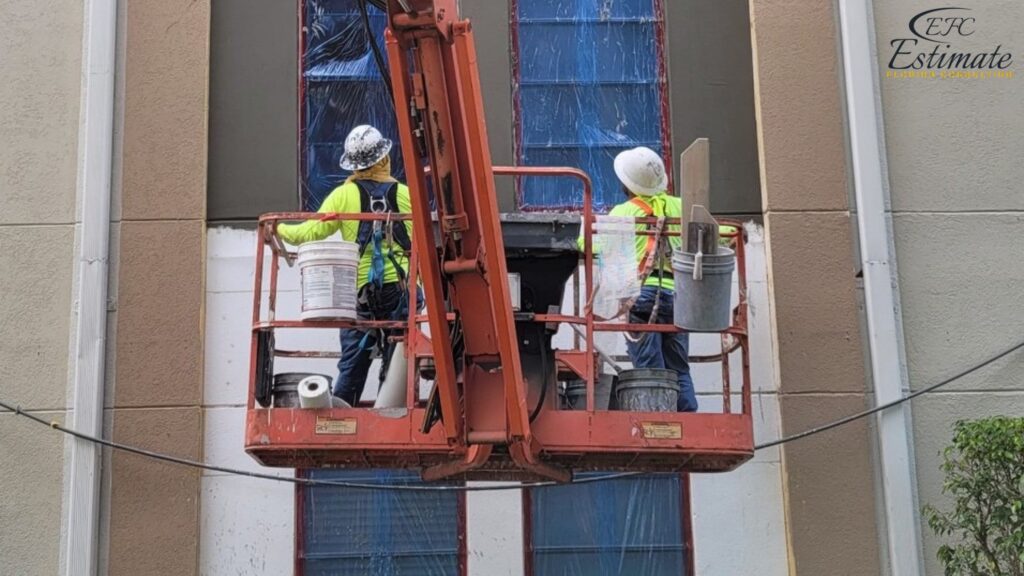
Doors and Windows:
Painting doors and window frames may cost an additional $195 – $520 per unit. These areas require precision and can be more time-consuming due to the need for careful masking and detail work. Well-painted doors and windows can improve the overall appearance of your home and increase its value. The use of contrasting colors for doors and windows can create a striking visual impact.
Decks and Porches:
Adding paint or stain to decks and porches can range from $910 to $3,250, depending on size and condition. Proper treatment of these areas can enhance durability and weather resistance, especially for outdoor structures exposed to the elements. Maintaining the finish on your decks and porches can extend their lifespan and improve safety. Regular staining or painting can protect wood surfaces from rot, warping, and insect damage.
Ongoing Exterior Painting Maintenance Costs
Maintaining the exterior paint is essential to protect your investment and keep your home looking its best. Regular maintenance can prolong the life of your paint job and help maintain your home’s curb appeal. By proactively addressing maintenance needs, homeowners can prevent more costly repairs and repainting efforts down the line.
Regular Touch-ups:
Addressing chips and wear promptly can prevent more extensive damage and save on future costs. Quick touch-ups help maintain the integrity of the paint and protect against environmental factors. Keeping a small amount of the original paint on hand can make touch-ups easier and more cost-effective.
Power Washing:
Annual cleaning helps preserve the paint’s appearance and lifespan, typically costing $130 – $390. Removing dirt and debris can prevent staining and deterioration of the paint surface. Regular cleaning can also reveal underlying issues that may need attention before they become major problems.
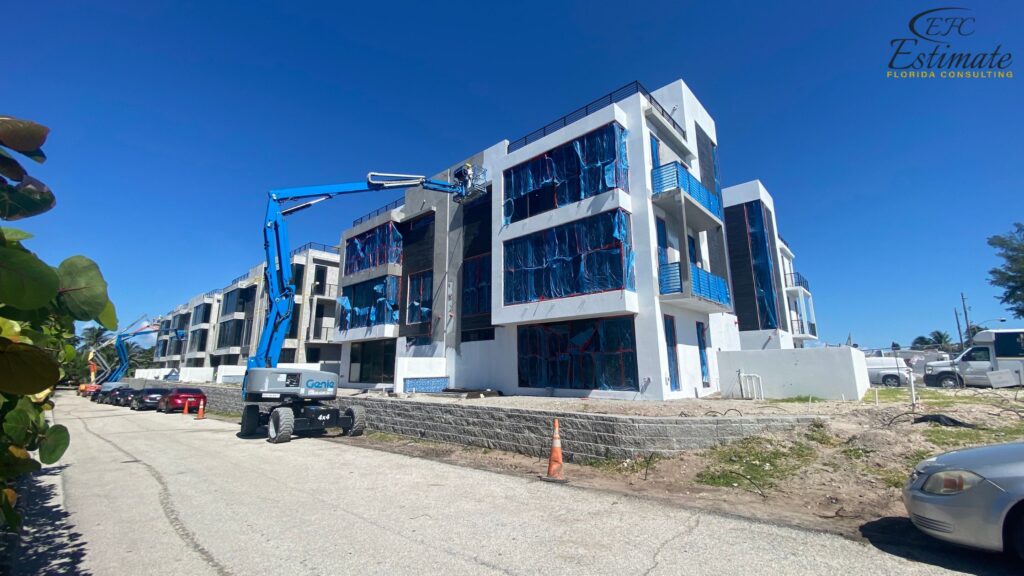
Repainting Schedule:
Plan to repaint every 5-10 years, depending on the quality of paint and local climate conditions. Regular inspections can help identify areas needing attention before significant issues arise. Following a consistent repainting schedule can keep your home looking fresh and well-maintained.
Cost to Paint the Exterior of a House Yourself
DIY painting can save on labor costs, but it requires significant time, effort, and expertise. Homeowners should consider the demands of the project and their own skill levels before committing to a DIY approach. While DIY can offer savings, it also comes with potential challenges that need to be carefully evaluated.
- Materials and Equipment: You’ll need to purchase paint, brushes, rollers, ladders, and safety gear, which can total $1,300 – $3,250. Proper tools and protective equipment are essential for achieving a professional finish safely. Investing in quality materials can enhance the outcome of your DIY project.
- Skill Level: Achieving a professional finish requires experience and attention to detail. Uneven application or missed spots can detract from the final appearance and require costly corrections.
- Time Commitment: Painting a house exterior is labor-intensive and can take several days or weeks, depending on your availability and weather conditions. Coordinating the project around personal schedules and weather forecasts is crucial for successful execution.
Get Acquainted with Exterior Painting
Cost to DIY vs. Hiring a Professional Painter
When deciding between DIY and hiring a professional, consider the following:
DIY Cost: While you may save on labor, the total DIY cost can range from $2,600 to $6,500, factoring in materials and time. DIY projects may also entail unforeseen challenges that can increase time and expense.
Professional Painter Cost: Hiring experienced painters ensures quality work and timely completion, with costs ranging from $7,800 to $23,400. Professionals offer expertise and access to high-quality materials, often resulting in a more durable and aesthetically pleasing finish.
Quality and Durability: Professionals bring expertise and access to high-quality materials, often resulting in a more durable and aesthetically pleasing finish. Their experience allows for efficient project completion and superior results that enhance your home’s value.
Additional Considerations for Exterior Painting
Eco-Friendly Paint Options
To maximize the longevity of your exterior paint job, regular maintenance is key. This includes periodic inspections for peeling, cracking, or fading, and addressing minor repairs promptly to prevent further damage. Investing in high-quality paint and proper application techniques will also extend the lifespan of your paint job, reducing the frequency of repaints. Regular paint maintenance, such as cleaning surfaces and touching up areas exposed to harsh conditions, helps in preserving the look and durability of your home’s exterior.
Choosing the Right Contractor
Selecting the right painting contractor is crucial for achieving a high-quality finish. It’s important to research potential contractors, check references, and verify credentials. A reputable contractor will provide a detailed estimate, clear communication, and quality workmanship. Ensuring that the contractor is licensed and insured can protect you from potential liabilities. When choosing a painting contractor, consider their experience, reviews, and whether they offer a warranty on their work, as these factors contribute to the overall satisfaction and quality of the project.
How to Choose the Best Exterior Paint Colors for Your Home?
Choosing the right exterior paint color is about more than just personal preference; it affects your home’s curb appeal and overall value. Here are some tips for selecting the best colors:
Download Template For House Painting Project Breakdown
- Materials list updated to the zip code
- Fast delivery
- Data base of general contractors and sub-contractors
- Local estimators

Consider Your Home’s Architecture
Choosing the right exterior paint colors starts with understanding your home’s architectural style. Each architectural design has its own historical color palette and aesthetic that can guide your choices. For instance, Victorian homes, known for their elaborate details and gingerbread trim, often look best in pastel shades, muted blues, greens, or even deep burgundies that highlight their intricate designs. Colonial and traditional homes typically favor classic colors like white, beige, and muted greys, which provide a timeless look that complements their symmetrical facades. On the other hand, modern and contemporary homes often embrace bolder choices, such as sleek blacks, dark greys, or crisp whites, paired with vibrant accent colors on doors or trim. Ranch-style homes can opt for earth tones like sage green, warm beige, or soft browns that blend seamlessly with natural surroundings. By aligning your color choices with the architectural style of your home, you not only enhance its curb appeal but also preserve its historical and aesthetic integrity, adding to its overall value.
Match the Neighborhood Aesthetic
While your home’s color should reflect your personal style, it’s also important to consider the overall aesthetic of your neighborhood. This is especially crucial if you live in a community with a homeowners association (HOA) that enforces specific color guidelines or restrictions. Even without formal guidelines, choosing colors that blend harmoniously with neighboring homes can help maintain a cohesive look and uphold property values across the community. For example, if your neighborhood is characterized by earth-toned homes, selecting a bright or unconventional color might not only clash but could also detract from your home’s resale value. Instead, look for ways to personalize within the existing color schemes—perhaps a unique trim color or a striking front door shade that sets your house apart subtly.
Think About Light and Shade
One of the most critical yet often overlooked aspects of choosing an exterior paint color is considering how light and shade affect the appearance of colors throughout the day. Natural light can significantly alter how a paint color looks on your home’s exterior. For example, a color that appears warm and inviting in the bright morning sun might look dull or even harsh under the intense afternoon light. Likewise, a shade that looks perfect in a small sample can appear much darker on a large exterior wall, especially in shaded areas. It’s important to test paint samples on various parts of your home—north, south, east, and west-facing walls—to observe how the colors change with the shifting light throughout the day.
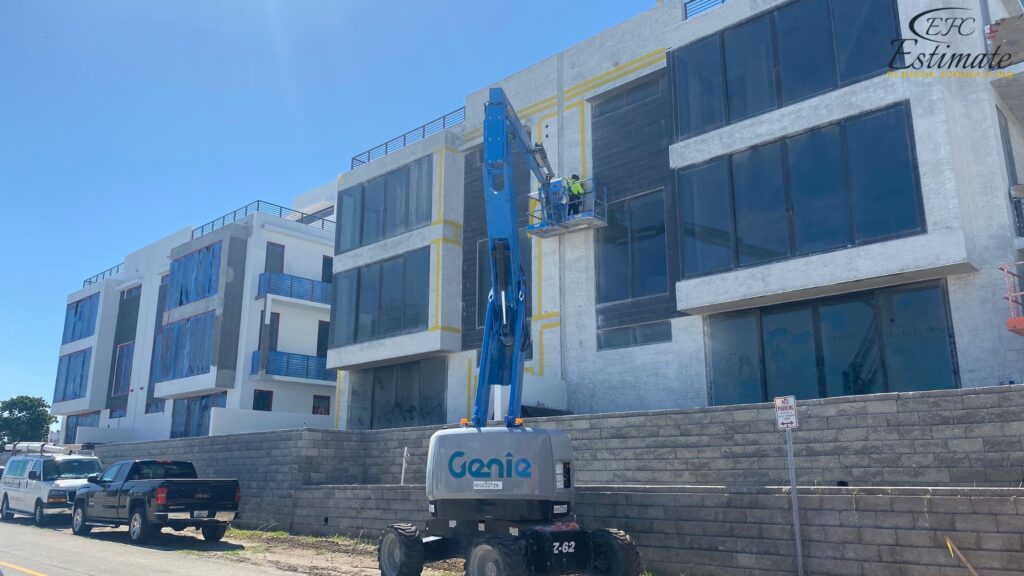
Use Color Accents
Using color accents is a powerful way to enhance your home’s exterior and create visual interest that draws the eye to specific architectural features. Accents can include trims, shutters, doors, and even smaller details like window sashes or railings. For example, a brightly colored front door, such as red, navy blue, or even yellow, can provide a striking contrast against neutral walls, instantly boosting curb appeal and creating a welcoming focal point. Trim colors, when chosen correctly, can either blend seamlessly with the main body of the house or stand out to highlight the home’s architectural lines and shapes. For instance, white or off-white trims can make windows and doors pop against a darker exterior, while darker trims can add depth and sophistication to lighter-colored homes. When selecting accent colors, it’s essential to maintain a sense of balance; too many contrasting colors can make the exterior look disjointed and busy. Instead, aim for two or three colors that complement each other and work in harmony. This approach ensures that the accents enhance rather than overwhelm the overall design.
How Often Should You Repaint the Exterior of a House?
Wood Siding: Repainting Every 3-7 Years
Wood siding, renowned for its classic charm and natural appeal, generally requires repainting every 3 to 7 years. This frequency is influenced by wood’s susceptibility to environmental elements such as moisture, sunlight, and temperature fluctuations. Wood is particularly vulnerable to issues like peeling, cracking, and warping, which can degrade the paint and compromise the protective barrier it provides. High-quality exterior paint and proper surface preparation can help extend the lifespan of a wood siding paint job, but even the best paints will eventually need touch-ups or a full repaint. Regular maintenance, including inspecting for signs of damage and addressing any issues promptly, is crucial. In regions with harsh weather conditions, such as heavy rainfall or intense UV rays, wood siding may require more frequent repainting to maintain its aesthetic appeal and structural integrity. By investing in durable paint and conducting regular upkeep, homeowners can effectively protect their wood siding and ensure a longer-lasting finish.
Stucco: Repainting Every 5-10 Years
Stucco is a popular choice for its durability and versatility, often lasting between 5 to 10 years between repaints. This range is contingent on the quality of the stucco finish and how well it is maintained. Stucco is less prone to issues like peeling and blistering compared to wood, but it can suffer from cracking due to settling or environmental stress. Using high-quality, flexible exterior paints designed for stucco can help mitigate these issues and provide a long-lasting finish. Regular inspections are essential to identify and repair any cracks or damage before they worsen, which helps extend the time between repaints.
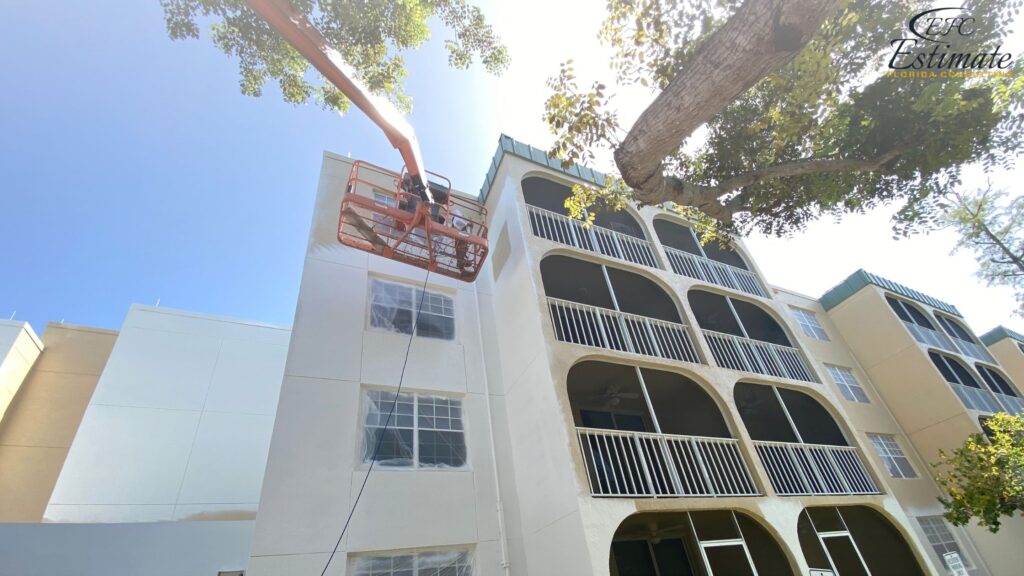
Stucco’s ability to hold paint well makes it a low-maintenance option compared to other materials, but it still benefits from periodic care to preserve its appearance and protect the underlying structure from moisture intrusion.
Vinyl and Aluminum Siding: Repainting Every 10-15 Years
Vinyl and aluminum siding are known for their low-maintenance characteristics and generally require repainting every 10 to 15 years. These materials are more resistant to fading, peeling, and cracking compared to wood and stucco, making them a popular choice for homeowners seeking durability and minimal upkeep. However, while they can hold paint for an extended period, it’s important to choose high-quality, exterior-grade paint that adheres well to the smooth surfaces of vinyl and aluminum. Proper surface preparation, including thorough cleaning and priming, is key to achieving a lasting finish. Although repainting might be less frequent with these materials, regular inspections for signs of wear, such as chalking or discoloration, can help ensure the siding remains in good condition. By maintaining the paint job and addressing minor issues early, homeowners can extend the life of their vinyl or aluminum siding and preserve its appearance.
Brick: Repainting Every 15-20 Years
Painted brick exteriors are among the most durable, often lasting 15 to 20 years before needing a fresh coat. The longevity of painted brick is attributed to its inherent strength and the ability of high-quality, breathable exterior paints to resist moisture and other environmental factors. Unlike other materials, brick is less prone to issues like peeling or blistering, provided that the paint used allows for proper moisture evaporation. Breathable paint is essential for brick surfaces to prevent trapped moisture from causing damage to both the paint and the underlying brickwork. Regular inspections to check for signs of wear or damage are still important, even with the extended lifespan. Proper maintenance and timely touch-ups can ensure the painted brick remains in excellent condition and continues to provide a protective and attractive exterior.
Regular Inspections and Maintenance
Regular inspections and proactive maintenance are critical to extending the life of any exterior paint job, regardless of the material. Conducting periodic checks for signs of damage, such as peeling, cracking, or fading, allows homeowners to address issues early and prevent more extensive repairs or premature repainting. Routine maintenance tasks include cleaning the exterior to remove dirt and debris, checking for signs of mold or mildew, and ensuring that gutters and downspouts are functioning correctly to prevent water damage. By staying vigilant and addressing minor problems before they escalate, homeowners can effectively extend the lifespan of their exterior paint job, saving both time and money in the long run. Regular upkeep not only preserves the aesthetic appeal of the home but also helps protect its structural integrity, ultimately ensuring a longer-lasting and more cost-effective paint finish.
Get 5 New Leads Next 7 Days With Our System
- Multi-Family House
- Single-Faimly House
- Modern House
- Duplex
- Ranch House
- Bungalow
Conclusion
Painting the exterior of a 3,000-square-foot house is a significant undertaking that can dramatically improve your home’s appearance and value. By understanding the factors that influence costs, including story height, siding type, and additional features, homeowners can budget effectively and make informed decisions. Whether choosing to hire professionals or tackle the project yourself, a well-executed paint job can transform your home into a stunning and inviting space for years to come. Proper planning and consideration of all relevant factors can ensure a successful outcome that meets your aesthetic goals and financial expectations.
FAQs
The cost to paint a 3,000-square-foot house exterior typically ranges from $6,000 to $24,000, depending on various factors such as the type of siding, the number of stories, the complexity of the design, and the quality of the paint used.
The number of stories impacts the cost significantly. Single-story homes are generally less expensive to paint ($4,550 – $9,750) due to easier accessibility. Two-story homes cost more ($7,800 – $15,600) due to additional labor and equipment needs, while three-story homes are the most expensive ($10,400 – $23,400) due to increased complexity and safety requirements.
Siding material affects preparation and paint type, impacting the overall cost. Vinyl siding is the least expensive ($3,900 – $7,800), wood siding costs more ($5,200 – $11,050), stucco siding ranges from $6,500 to $13,000, and brick or stone siding is the most costly ($7,800 – $15,600) due to specialized paint and preparation needs.
Factors include the quality and type of paint, the extent of surface preparation, the complexity of the home’s design, and geographic location. High-quality paint and thorough preparation ensure durability but add to the cost. Complex designs and regional cost variations also affect the final price.
DIY painting can save on labor costs, with expenses ranging from $2,600 to $6,500 for materials and equipment. However, hiring a professional ensures quality work and timely completion, with costs between $7,800 and $23,400. Professionals offer expertise and access to high-quality materials, often resulting in a more durable finish.
Regular maintenance is essential to protect the investment. Costs include regular touch-ups for chips and wear, annual power washing ($130 – $390), and a repainting schedule every 5-10 years. Proactive maintenance helps extend the paint’s lifespan and maintains the home’s curb appeal.
Google Reviews

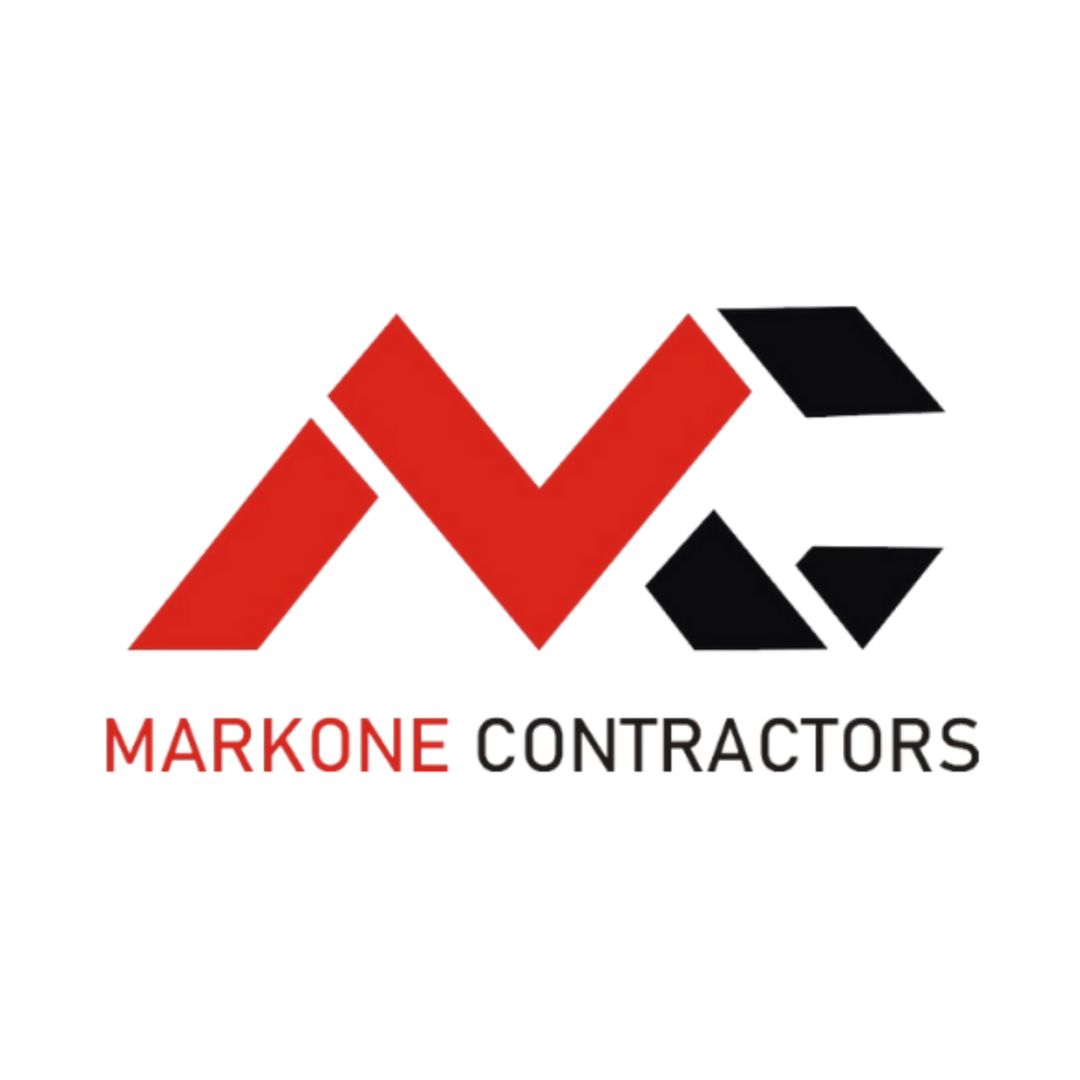

Process To Get House Painting Cost Estimate Report
Here I am going to share some steps to get house painting cost estimate report.
-
You need to send your plan to us.
You can send us your plan on info@estimatorflorida.com
-
You receive a quote for your project.
Before starting your project, we send you a quote for your service. That quote will have detailed information about your project. Here you will get information about the size, difficulty, complexity and bid date when determining pricing.
-
Get Estimate Report
Our team will takeoff and estimate your project. When we deliver you’ll receive a PDF and an Excel file of your estimate. We can also offer construction lead generation services for the jobs you’d like to pursue further.

